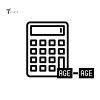AP Biology Score Calculator
Calculate your AP Biology exam score with interactive sliders for each question
The AP Biology exam uses a composite scoring system that combines your performance on both sections:
AP Score Cutoffs:
- 5 - Extremely Well Qualified: 75-100 points
- 4 - Well Qualified: 60-74 points
- 3 - Qualified: 45-59 points
- 2 - Possibly Qualified: 30-44 points
- 1 - No Recommendation: 0-29 points
Free-Response Question Breakdown:
- Questions 1 & 2: Long free-response questions (10 points each)
- Questions 3-6: Short free-response questions (4 points each)
This calculator provides estimates only. Your official AP score may vary.
RELATED TOOLS Master Your Score: The Ultimate Guide to Using an AP Biology Score Calculator
Navigating the challenging waters of AP Biology requires more than just understanding cellular respiration and genetics; it demands strategic preparation. After pouring hours into studying, how can you truly gauge your readiness for the exam? The answer lies in a powerful tool: an AP Biology score calculator. This guide is your definitive resource for not only using this tool effectively but also for building a study plan that transforms your calculated score from a source of anxiety into a roadmap for success. We will demystify the scoring process, show you how to leverage an AP Biology exam score calculator with confidence, and connect it all to a robust study strategy that leverages the best official resources.
Demystifying the AP Biology Exam Score
Before you can effectively use any AP Biology calculator, you must first understand the machine it’s simulating. Your final score on the 1-5 scale is not a simple percentage; it’s a composite result derived from two equally weighted sections. The College Board designs this system to holistically assess both your broad knowledge and your deep, analytical skills.
The exam is rigorously structured into two distinct parts:
Section I: Multiple-Choice and Multiple-Select Questions
You will face 60 questions in this section.
The scoring is straightforward: one point for each correct answer.
A critical strategy point: there is no penalty for incorrect or blank answers. This means you should make an educated guess on every single question. Leaving an answer blank guarantees zero points, while a guess gives you a chance.
Your raw score for this section is simply your total number of correct answers, giving you a potential 60 points.
Section II: Free-Response Questions (FRQs)
This section contains 6 written-response questions designed to test your ability to apply knowledge, analyze data, and articulate scientific arguments.
It typically includes 2 longer, more in-depth questions and 4 shorter questions.
The total number of points available across all 6 questions usually adds up to 50. Each question has a specific rubric, and points are awarded for demonstrating correct procedures, accurate explanations, and valid conclusions.
Your responses are graded by experienced AP teachers and professors using these standardized rubrics to ensure consistency and fairness.
The magic happens when these two scores are combined. Your final composite score is the sum of your raw points from Section I and Section II. This number, which can range from 0 to 110, is then converted into the familiar 1-5 AP score. This conversion process, known as equating, allows the College Board to maintain consistent standards from year to year, even if different exam versions vary slightly in difficulty.
Your Step-by-Step Guide to Using an AP Biology Score Calculator
A reliable AP Biology score calculator is more than just a number generator; it’s a diagnostic tool. To get the most accurate prediction, you must approach the process methodically. Rushing through a practice test or being overly generous when grading your own work will only lead to a misleading result.
Follow this precise, four-step process to get a true measure of your standing:
Simulate Real Exam Conditions: This is non-negotiable. Find a quiet space, set a timer for 90 minutes for each section, and take a full-length practice test in one sitting. This builds the mental stamina you’ll need on exam day and gives you a realistic picture of your pacing under pressure.
Tally Your Multiple-Choice Raw Score: After completing Section I, grade your answers. Count the total number of questions you answered correctly. This is your raw score out of 60. Remember, do not subtract points for wrong answers.
Conduct a Rigorous Self-Grade for FRQs: This is the most challenging yet most crucial step. Access the official scoring guidelines for the practice test you are using. With a critical eye, grade your own free-response answers. Be honest and strict. Did you clearly state your claim? Did you correctly justify your reasoning? Tally the points you earned for each question according to the rubric to find your total FRQ raw score, which is typically out of 50 points.
Input and Interpret the Data: Enter your two raw scores into a trustworthy AP Biology exam score calculator. The tool will process these numbers based on historical scoring curves and provide an estimated AP score on the 1-5 scale.
It is vital to remember that the output is an estimation. The official cut-off ranges for scores of 3, 4, and 5 can fluctuate slightly each year. However, using a well-designed calculator provides a highly reliable prediction that is invaluable for shaping your final weeks of study.
OUR TOP TOOLS Answering Your Key AP Biology Questions
Embarking on the AP Biology journey naturally brings up important questions about the challenge ahead. Let’s address the most common concerns students have.
A question we hear constantly is, “Is AP Biology hard?” or, more specifically, “How hard is AP Biology?” The candid answer is that it is widely regarded as one of the more demanding AP courses. The difficulty doesn’t just come from the volume of content—which includes intricate topics like gene regulation and signal transduction—but from the depth of understanding required. The modern exam focuses less on rote memorization and more on your ability to apply concepts, analyze experimental data, and connect ideas across different units. This analytical leap is what many students find challenging, but it is a skill that can be mastered with focused practice.
Understanding the logistics of the exam is also key to managing stress. So, how long is the AP Biology exam? The total appointment time is 3 hours, strategically divided to test different skills:
Section I: 90 minutes for 60 multiple-choice questions. This gives you an average of 1.5 minutes per question, requiring a steady pace.
Section II: 90 minutes for 6 free-response questions. This section demands efficient time management to ensure you can adequately address each prompt, especially the two longer questions.
Knowing this structure allows you to practice not just the content, but the pacing itself, turning the exam from a sprint into a manageable, paced effort.
Building an Unbeatable AP Biology Study Plan
Knowing the challenge is only half the battle. Conquering it requires a strategic and proactive study plan. An AP Biology calculator tells you where you are; a great study plan charts the course to where you need to be.
Here’s how to build a study strategy that works in tandem with your score predictions:
Start Early and Space Out Your Learning: Cramming is the enemy of deep understanding. The complex concepts in AP Biology need time to marinate. Create a study schedule months in advance and review material consistently, revisiting older topics to keep them fresh.
Prioritize Application Over Memorization: Shift your mindset from “what do I need to know?” to “how is this concept applied?” Focus on designing experiments, interpreting graphs, and explaining biological processes in your own words. This is the skill set the FRQ section is designed to assess.
Make the Free-Response Section a Friend, Not a Foe: Many students avoid FRQ practice because it is difficult and time-consuming. You must do the opposite. Regularly schedule sessions where you write out full responses to past questions. Then, critically self-grade using the official rubrics. This is the single most effective way to improve your score.
Anchor Your Practice in Official Material: While many resources are available, the gold standard for preparation is the College Board itself. You should integrate official AP Biology practice questions into your weekly study routine. These released questions from previous exams provide the most accurate representation of the content, style, and level of difficulty you will face. Using an AP Biology score calculator after completing these official practice tests yields the most reliable performance prediction.
From Prediction to Performance: Using Your Score Strategically
The true power of an AP Biology exam score calculator is realized when you use it not as a final judgment, but as a diagnostic launchpad. A low predicted score is not a failure; it’s a data point that tells you where to focus your energy.
For example, if you use the calculator and discover your score is being pulled down by a low multiple-choice performance, you know you need to broaden your content review and practice with more MCQs. If your FRQ score is the weak link, you must double down on writing practice, focusing on constructing clear, concise, and rubric-aligned responses. Go back to specific units where you lost points—be it ecology or cellular energetics—and drill down into those topics with targeted reading and more specific AP Biology practice questions.
This cycle of practice, calculation, analysis, and targeted review is what separates students who simply hope for a good score from those who actively build one. The AP Biology calculator is the compass that keeps you oriented on this journey.
Conclusion: Empower Your Exam Journey
The path to a top score on the AP Biology exam is a challenging but achievable endeavor. It requires more than just intelligence; it requires strategy and self-awareness. A reliable AP Biology score calculator is a cornerstone of that strategy, providing the clarity and feedback necessary for targeted improvement. By thoroughly understanding the exam’s scoring system, using the calculator as a rigorous diagnostic tool, and pairing its insights with a disciplined study plan rooted in official practice, you transform uncertainty into confidence. You have the potential and now you have the blueprint. Take the next step, put these tools into action, and unlock the score you are capable of achieving.








